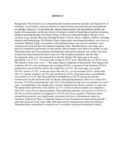| dc.description.abstract | Background:
Thyrotoxicosis is an important and common endocrine disorder with high levels of morbidity. Local studies on the prevalence of control and the associated thyroid autoantibodies are lacking.
Objective:
To determine the clinical characteristics, the autoantibody profile, the modes of management and the prevalence of adequate control of hyperthyroid patients attending Medical and Radiotherapy Out-Patient Clinics at Kenyatta National Hospital.
Design:
Cross-sectional study.
Setting:
Kenyatta National Hospital, Nairobi, Kenya.
Subjects:
Patients attending Medical and Radiotherapy Out-Patient Clinics diagnosed to have hyperthyroidism, who were on treatment.
Methods
Eighty one patients with hyperthyroidism who were on treatment, were consecutively recruited from the medical outpatient clinic. Detailed history was taken and a physical examination performed on each patient. Blood samples were drawn for profiles of anti- Thyroperoxidase and Thyroglobulin autoantibodies and thyroid function tests which were done by Enzyme Linked Immunosorbant Assay test. The treatment modalities and the other investigations done were documented from the file.
Results
The mean age of the study participants was 37.8 +/- 12.6 years with a range of 15-67 years. The peak age was 26-35 years. The female to male ratio was 9: 1.
The major clinical symptoms of the patients were fatigue and weakness (96.3%), heat intolerance and sweating (93.8%), awareness of the heartbeat (93.8%), hyperactivity and irritability (86%) and weight loss (76.5%). The main signs were goitre (91.4%), tremor (75.3%), warm and moist skin (64.2%), eye involvement (63%), tachycardia (48.1 %), muscle weakness (41.5%) and onycholysis (9.3%).
Thyroperoxidase autoantibodies were positive at 41.5% and Thyroglobulin autoantibodies at 38.5% among the patients.
Carbimazole was the preferred mode of therapy although biochemical control was achieved in less than 113 of the treated patients with 38% of the patients having been on treatment for over 2 years.
Autoantibodies were significantly common among Graves disease patients, as expected. Thyroperoxidase antibodies were positive in 41 % of Graves disease patients as compared to only 2.4% in non-Graves disease patients. Thyroglobulin antibodies were positive in 38.5% of the Graves disease patients as compared to 2.4% in non¬Graves patients. Thyroperoxidase autoantibody positivity was significantly associated with lack of biochemical control on treatment.
Conclusion
There is a high prevalence of poor biochemical control among patients with thyrotoxicosis in the clinic. Only 29% had achieved biochemical control on treatment. Thyroperoxidase autoantibody seropositivity is associated with poor biochemical control. | en_US |

